
3I/ATLAS, the intriguing interstellar object, has recently been identified as a focal point in a new campaign launched by the International Asteroid Warning Network (IAWN). This initiative, which is backed by the United Nations, aims to enhance Earth’s defenses against potentially hazardous space objects. The IAWN is a collaborative effort that includes organizations and individual astronomers from around the globe, all dedicated to detecting, monitoring, and characterizing asteroids and other Near-Earth Objects (NEOs).
On October 21, 2025, coinciding with the solar conjunction of 3I/ATLAS relative to Earth, IAWN made a pivotal announcement. They noted that comets present unique challenges regarding accurate astrometric measurements and orbital predictions. Unlike typical celestial bodies, comets have extended features such as comae and tails, which can skew measurements of their centroid—thereby complicating trajectory estimations.
The IAWN has scheduled a comet campaign from November 27, 2025, to January 27, 2026, specifically targeting 3I/ATLAS (C/2025 N1). This campaign aims to develop methods that enhance astrometry derived from comet observations. To facilitate this, IAWN will host a workshop focused on comet astrometry techniques, requiring registration by November 7th. Participation in the campaign will be limited to those who attend this preparatory workshop.
This announcement follows a significant White Paper I submitted on September 30, 2025, in collaboration with Omer Eldadi and Gershon Tenenbaum. This document, which can be accessed online, advocated for a coordinated global scientific effort to maximize the observational coverage of interstellar objects like 3I/ATLAS. The potential threat posed by these objects, particularly if they harbor alien technology, necessitates serious consideration of black swan events—rare occurrences that could have profound implications for humanity.
Currently, 3I/ATLAS has demonstrated eight surprising qualities that contribute to its ranking of 4 out of 10 on the Loeb scale, which assesses the likelihood of a technological origin. These attributes include:
Its trajectory aligns within 5 degrees of the ecliptic plane, with a likelihood of only 0.2%. In July and August 2025, it exhibited a sunward jet (anti-tail) that cannot be attributed to geometric illusions, setting it apart from known comets. The nucleus of 3I/ATLAS is approximately a million times more massive than 1I/`Oumuamua, moving faster than both known interstellar objects, with a likelihood of less than 0.1%. Its arrival was precisely calibrated to bring it within millions of kilometers from Mars, Venus, and Jupiter, making it unobservable from Earth at perihelion, with a likelihood of 0.005%. The gas plume surrounding 3I/ATLAS contains significantly more nickel than iron, with a nickel-to-cyanide ratio orders of magnitude higher than that of known comets, with a likelihood below 1%. Only 4% of its gas plume is water by mass, a stark contrast to typical comets. 3I/ATLAS exhibited extreme negative polarization, an unprecedented phenomenon among known comets. It arrived from a direction closely aligned with the radio “Wow! Signal,” with a likelihood of 0.6%.Multiplying these probabilities yields a cumulative likelihood of occurrence lower than one in ten quadrillion (1016), underscoring the need for comprehensive observational strategies to investigate the nature of 3I/ATLAS.
Unfortunately, there are currently no spacecraft capable of intercepting 3I/ATLAS for close study. Effective planning and early detection are essential for future missions to explore such objects. In collaboration with Adam Hibberd and Adam Crowl, our research indicated that if NASA’s Juno spacecraft had its initial fuel, it could have intercepted 3I/ATLAS near Jupiter on March 16, 2026.
This concept was also highlighted in a visionary letter by U.S. Congresswoman Anna Paulina Luna to NASA’s Interim Administrator, Sean Duffy, on July 31, 2025. The clearest signs of technological activity from 3I/ATLAS could be detected through maneuvers or the release of mini-probes near perihelion on October 29, 2025. The optimal conditions for such maneuvers would be at its closest approach to the Sun, taking advantage of the Oberth effect for energy-efficient spacecraft operations.
If 3I/ATLAS is indeed a massive mothership, it might continue on its original trajectory while releasing mini-probes that could utilize the Sun’s gravitational assist to navigate towards planets like Earth. To prepare for any unusual activity from extraterrestrial technological objects, I have tasked the research team at the Galileo Project Observatories to monitor developments closely, especially as 3I/ATLAS approaches Earth on December 19, 2025. With any luck, we will gain more insights about our interstellar neighbor by Christmas.
As our understanding of interstellar objects like 3I/ATLAS evolves, the collaboration between global scientific communities will be crucial in unraveling the mysteries of these celestial visitors. The upcoming IAWN campaign marks a significant step towards enhancing our readiness to study and respond to potential threats from space.